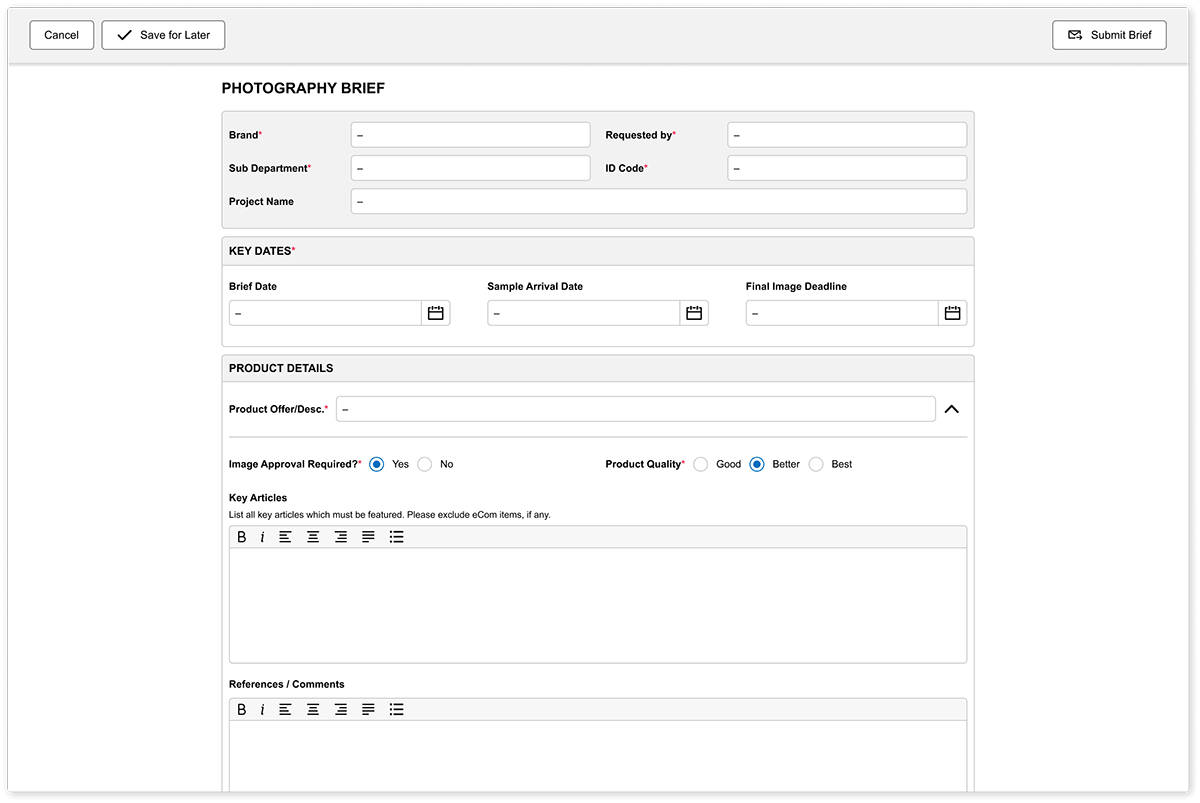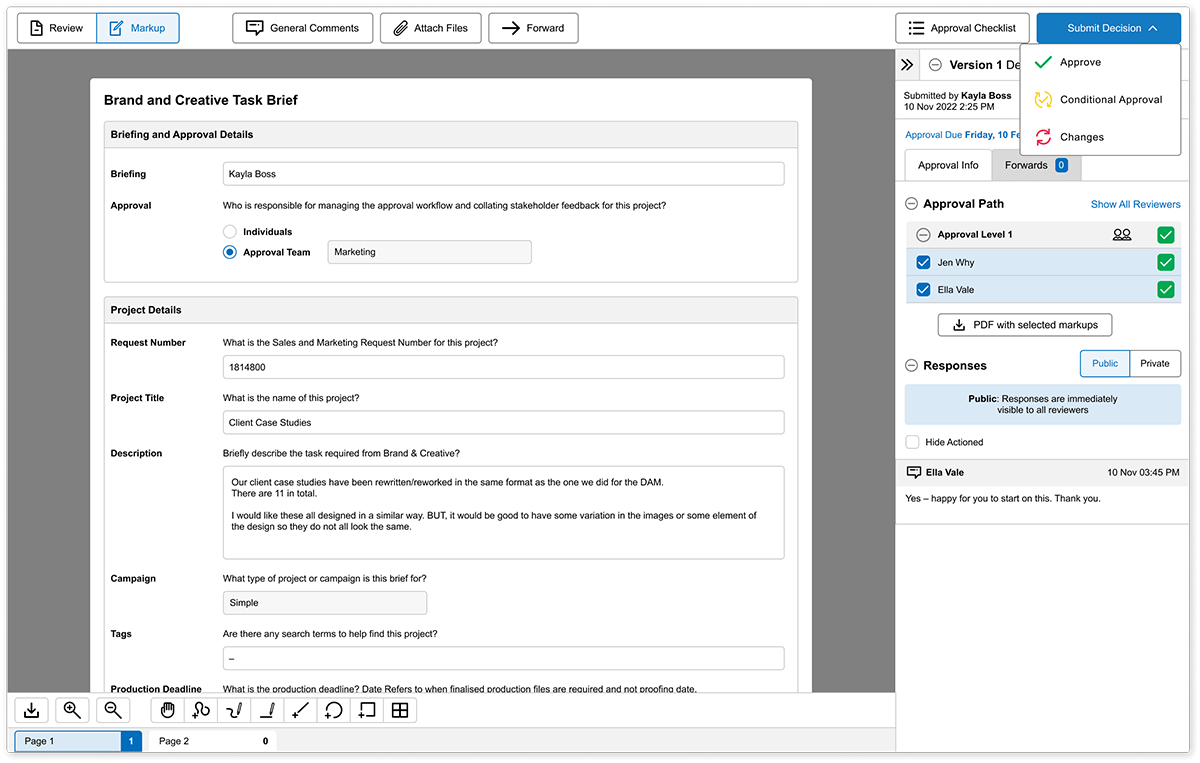Got Bad Briefing Habits? Here's How Admation Helps You Brief Better
By Jodie Byass
The creative brief isn’t just paperwork; it’s the cornerstone of your marketing project. Yet, briefing often turns out to be a challenge even for seasoned professionals. A well-written brief should confidently leverage creative and strategic assets, allowing for a more organic and impactful creative outcome without the need for excessive control. A startling study points out that a whopping 30% of agencies’ wasted time can be attributed to poor client briefing. That inefficiency translates into more than just lost time—it affects your project management, strains your internal resources, and slows down your go-to-market strategy. If you find yourself bogged down by ineffective briefing habits, it’s high time to review how you manage your project briefs for a better creative workflow and enhanced marketing project management.
The Cost of Bad Briefing: By the Numbers
While the creative brief is universally acknowledged as a valuable tool, it’s ironic that it often goes neglected. Both marketers and agencies concur that a well-crafted brief is indispensable for producing quality work, yet there seems to be a disconnect when it comes to executing it effectively. Here’s a deeper look into the statistics that shed light on this paradox:
- The Brief’s Value and Neglect: An overwhelming 90% of marketers and 92% of agencies agree that the creative brief is one of the most valuable—yet paradoxically, most neglected—tools available to generate quality output.
- Difficulty in Brief Writing: About 82% of marketers and 83% of agencies admit that writing an effective brief is a challenging task. This confirms that the struggle isn’t isolated to one side; it’s an industry-wide issue.
- The Perception Gap: While a staggering 80% of marketers believe they excel at writing briefs, only 10% of creative agencies share this sentiment. This suggests a significant gap in perception and expectations between the two.
- Understanding of Brief Requirements: On the flip side, 80% of creative agencies believe that marketers possess a poor or limited understanding of what is actually needed from a brief.
- Brief Changes: Post-submission changes in briefs are quite common, with 90% of marketers admitting that their briefs undergo modifications after they have been submitted.
- The Impact of Rebriefing: When it comes to rebriefing, marketers are generally aware of the negative impacts: 43% acknowledge time lost, and 18% recognise added costs.
- Financial Ramifications: Astonishingly, it is estimated that nearly one-third of marketing budgets are wasted on poorly crafted briefs and misdirected work.
Given the substantial cost, both in terms of time and resources, bad briefing habits can no longer be an oversight. These statistics underscore the urgency for a streamlined, effective briefing process—something Admation’s Marketing Management and Approval software excels at. By adopting such a solution, you can bring much-needed alignment between marketers and creative agencies, effectively manage creative agency projects, and ultimately, improve your go-to-market strategy.
Understanding the Importance of a Good Brief
A good brief is the foundation of a successful marketing campaign. It serves as a bridge between the strategic plan and the execution of the campaign, ensuring that all stakeholders are aligned and working towards the same objectives. A well-written brief can elevate marketing skills, achieve the desired creative outcome, and ultimately drive business results. On the other hand, a bad brief or a poorly written brief can lead to a lack of control over strategy, a struggle to achieve the desired creative outcome, and wasted resources.

How to Improve the Creative Briefing Process: A Structured Approach
In light of the statistics and challenges presented earlier, there’s a palpable need for enhancing the briefing process. Focusing on the primary consumer benefit or in the case of B2B, the key business outcome is crucial to ensure your message is clear and impactful. The good news is, there are actionable steps you can take to improve your bad brief and avoid common pitfalls. Let’s dive into some key areas that can bring immediate improvements:
Bring More Structure to the Briefing Process
More than 7 in 10 marketers believe that project briefings and brand strategy could be vastly improved with a more structured approach. Brand positioning focuses on identifying and winning specific emotional zones that resonate with your buyers and consumers. Admation’s marketing project management software allows for tailored online briefs that capture all necessary details—budgets, milestones, keywords, and more—right upfront. This ensures that all stakeholders are aligned and there are no grey areas, thereby reducing the room for misinterpretation and misdirection.
Benefits:
- Improved alignment among stakeholders.
- Reduced need for post-briefing clarifications, saving valuable time.
Ensure the Right Sign-offs Internally
One of the recurring issues is that often the right people are not signing off on the marketing briefs. Ensuring that the marketing and creative team covers a wide range of media options can help visualise different concepts before final decisions are made. The impact of this is more significant than it appears at first glance. It leads to unnecessary revisionsand hampers the project’s smooth progress. Admation’s brief approvals feature allows you to nominate stakeholders who are critical for approval, ensuring that the brief receives the right internal vetting before any work begins.
Benefits:
- Eliminates bottlenecks by ensuring the right approvals upfront.
- Reduces the likelihood of future changes and rebriefing, cutting down on both time and costs.
Incorporating these best practices can bring a significant turnaround in how you manage creative projects. Admation’s features are tailored to address these exact pain points, offering a comprehensive solution for your marketing approval, media planning, and project management needs.
Key Elements of a Smart Brief
A smart brief is one that is concise, clear, and focused. It should include a clear and concise statement of the objective, target market, main message, and desired consumer response. A smart brief should also define the brand’s unique value proposition, key differentiators, and the emotional connection it wants to make with its audience. Additionally, a smart creative brief should provide a clear understanding of the brand’s tone, personality, and language, as well as any specific creative requirements or guidelines.
Managing Briefs Made Easy with Admation
Incorporating features specifically designed to make briefing as efficient and effective as possible, Admation transforms the briefing process. By streamlining the creative process, Admation ensures that creative briefs are well-crafted and address the buyers problems or challenges, leading to more innovative solutions. Here’s a closer look at the six ways Admation enhances this critical activity:
1. Online Briefs: Customisable for Your Creative Team and Project Types
Gone are the days of fragmented conversations and incomplete briefs via email. Creative brief examples can provide valuable insights into developing effective marketing strategies. Admation’s online briefing forms come tailored to both the organisation and various project types. These comprehensive forms capture all essential information like project overviews, budgets, milestones, keywords, tags, audience, regions and attachments. This structured approach minimises guesswork and time-consuming back-and-forths, setting the stage for a successful project.
Benefits:
- Enhanced stakeholder communication and alignment. Creating separate creative briefs for different marketing objectives, such as brand penetration and usage, allows for better resource allocation and focus on each strategy.
- Reduced project delays and guesswork.
- Improved accuracy in understanding project requirements.

2. Briefing Templates: Streamline Your Routine
Admation's brief templates enable marketers to create reusable templates for recurring campaign types. This feature is a timesaver that ensures consistency and quality in every new project.Benefits:
- Increased efficiency in project initiation.
- Consistent brief content and structure.
- Simplified project setup for recurring campaign types.
3. Centralise, Re-Use, and Duplicate Information: Your One-Stop Hub
Admation goes beyond serving as a centralised platform for all project-related files, including creative briefs. In addition to safeguarding your documents and enhancing accountability, the platform also lets you duplicate previously approved or submitted briefs. With just a few clicks, you can update these duplicates with new dates or target markets, saving you precious time and effort.
Benefits:
- Streamlined access and duplication of past briefs.
- Boosted stakeholder transparency and accountability.
- Efficient collaboration and easy brief updates.
4. Auto-Generate Projects: Say Goodbye to Manual Re-Entries
Once a brief is approved, Admation automatically generates a new project based on the brief’s details. This feature ensures that each creative idea presented is visualised in various formats, such as a 30-second TV script, a billboard, and a long-copy print ad, during the briefing stage. This feature eliminates the need for manual re-entry of project information, thereby expediting the project initiation process.
Benefits:
- Faster transition from brief approval to project commencement.
- Elimination of human errors associated with manual data entry.
- Time savings that can be reallocated to more strategic tasks.
5. Brief Approvals: Collaborate and Validate
Admation revolutionises the approval process. Writing such a great brief allows for creative freedom and minimises control over the outcome. Nominated stakeholders can quickly review and provide input, ensuring alignment before the project begins. This eliminates the need for post-brief clarifications and excessive revisions.
Benefits:
- Quick approval process reduces delays.
- Improved collaboration and stakeholder buy-in.
- Reduced need for artwork revisions.

6. Accuracy and Control: Mandatory Fields for Full Compliance
Admation’s mandatory fields in the creative brief forms ensure that no critical information is missed. This prevents the creation of an incomplete creative brief, which can hinder the effectiveness of a marketing campaign. This level of control ensures that every marketing project starts on the right foot, fully aligned with your marketing strategy and compliance requirements.
Benefits:
- Assurance of complete and accurate creative briefs, leading to more effective projects.
- Improved marketing compliance by ensuring all mandatory information is captured.
- Reduced risk of project delays due to incomplete or inaccurate briefs.
With these benefits outlined, it’s clear that Admation provides a 360-degree solution for managing digital and social media briefs, from project inception to completion. The platform’s capabilities help you optimise each step of the process, leading to more effective and efficient marketing campaigns.
Common Mistakes to Avoid
There are several common mistakes to avoid when writing a brief. One of the most common mistakes is making the brief too long or too vague. A brief should be concise and to the point, avoiding unnecessary details or jargon. Another mistake is failing to define the target market or desired consumer response clearly. A brief should also avoid being too prescriptive, allowing the brand strategy based creative team the freedom to develop innovative solutions. Finally, a brief should not be written in isolation, but rather in collaboration with the creative team and other stakeholders.
How Admation Can Help
Admation is a marketing workflow management tool that can help streamline the briefing process and ensure that all stakeholders are aligned and working towards the same objectives. Admation provides a centralised platform for creating, managing, and sharing briefs, as well as tracking progress and feedback. With Admation, marketers can create smart briefs that are concise, clear, and focused, and that provide a clear understanding of the brand’s objectives, target market, and desired consumer response. Admation can also help reduce errors and miscommunication, and ensure that all stakeholders are working towards the same goals.
In a landscape where inefficient briefing can cause significant time and resource drain, Admation emerges as an indispensable solution for enhancing your marketing project management and creative workflow. Without meaningful insights, data points are just a bunch of superficial information that lacks the narrative depth necessary for effective storytelling and consumer insights. Its comprehensive features tackle the core issues that plague the briefing process, bringing alignment and efficiency where it’s most needed. From online briefs tailored to your organisational needs, to streamlined approval processes, to the ability to centralise and even duplicate prior briefs, Admation is your one-stop hub for eliminating bad briefing habits.
The financial and operational costs of poor briefing are too high to ignore. As the data reveals, this isn’t just a challenge; it’s an industry-wide predicament that needs urgent redress. With Admation, you’re not just investing in software—you’re investing in a strategy for more effective, efficient, and compliant marketing campaigns. Don’t let poor briefing be the weak link in your marketing chain; let Admation redefine how you manage your creative projects and approvals.
To learn more about marketing project briefs, their pivotal role in brand success, the challenges they bring, and the solutions that technology offers, watch our video where Margaret Foley, Simple’s Chief Customer Officer and renowned subject matter presents Mastering Marketing Project Briefs: A Deep Dive into Effective Briefing.
Source: Data is sourced from Better Briefs Global report which can be accessed here


